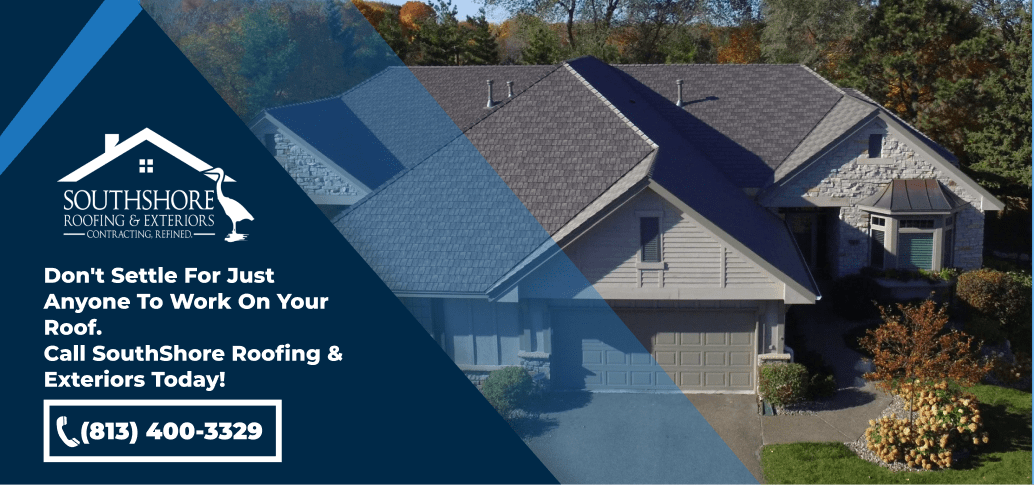Tampa homeowners face specific challenges during hurricane season, with intense storms and high winds threatening property integrity year after year. As weather patterns intensify across Florida, selecting the right wind-resistant roof has never been more critical for long-term home protection. The best wind-resistant roof options of 2025 offer significant advancements in durability, design, and performance compared to traditional materials.
Recent innovations in hurricane-proof roofing materials have dramatically improved how homes withstand extreme weather conditions. Modern impact-resistant roof shingles can now endure wind speeds exceeding 150 mph, while specialized fastening systems create stronger connections between your roof and home structure. These high wind-rated roof systems incorporate cutting-edge technology specifically engineered to resist uplift during severe storms.
Storm-resistant roof designs have also evolved, with aerodynamic profiles that reduce wind pressure and prevent the catastrophic failures seen in older roofing systems. For Tampa residents, these durable roofing systems for extreme weather provide peace of mind when storm warnings appear. The latest wind-resistant technologies not only protect your home but also reduce long-term maintenance costs and extend your roof’s lifespan.
Understanding your options for wind-resistant roofing materials is the first step toward creating a truly resilient home in Tampa’s challenging climate. The following guide examines the most effective storm-proof roofing solutions available for 2025 and beyond.
Metal Roofing Systems: The Gold Standard for Hurricane Protection
Metal roofs have established themselves as the premier choice for Tampa homeowners seeking maximum protection against hurricane-force winds. Standing seam metal roofs lead the category with impressive wind ratings of 140 mph, well exceeding Florida’s building code requirements. These systems feature raised seams that connect panels together, creating a virtually seamless surface that prevents wind from catching underneath.
Metal shingles are another excellent option, combining traditional aesthetic appeal with superior wind resistance. For Tampa’s severe weather conditions, metal roofs provide unmatched durability against both high winds and wind-driven rain that often accompanies tropical storms.
The wind resistance of any metal roof system depends heavily on proper installation techniques. Hidden fastener systems outperform exposed fasteners in high-wind scenarios, eliminating potential failure points. Quality underlayment with sealed seams creates a critical secondary moisture barrier, while reinforced attachment points at eaves and ridges, areas most vulnerable to wind uplift, significantly enhance performance.
The durability of metal roofs during extreme weather shows why insurance companies often offer premium discounts for Tampa homes with professionally installed metal roofs. Beyond immediate storm protection, these hurricane-proof roofing systems typically last over 50 years with minimal maintenance, making them a smart long-term investment for Florida homeowners.
Impact-Rated Asphalt Shingles: Affordable Protection Against Flying Debris
Class 4 impact-resistant asphalt shingles are a significant upgrade over standard shingles when it comes to withstanding Tampa’s severe weather conditions. These specialized shingles feature reinforced fiberglass mats and modified asphalt with rubberized polymers that dramatically improve their ability to resist wind uplift. While standard shingles typically carry wind ratings of 60 to 80 mph, impact-resistant varieties can withstand sustained winds of over 100 mph when correctly installed. In many Tampa neighborhoods, homes with Class 4 shingles experience less roof damage compared to those with conventional materials.
When selecting wind-resistant asphalt shingles for your Tampa home, look for products that carry both UL 2218 Class 4 impact ratings and ASTM D7158 Class H wind resistance certifications. The most reliable manufacturers will offer enhanced warranty coverage specifically addressing high-wind performance in coastal regions. Tampa homeowners should also verify that their chosen product features reinforced nailing zones and adhesive strips designed to create a stronger seal between shingles, critical features that prevent wind from lifting and tearing away shingles during intense storms.
Concrete and Clay Tiles: Traditional Strength Meets Modern Engineering
Concrete and clay tile roofing systems are designed to stay in place during Tampa’s hurricane season. Today’s engineered tile systems can withstand winds exceeding 150 mph when installed with advanced mechanical fastening methods. These systems typically use corrosion-resistant screws that secure tightly to the roof deck rather than traditional nails, creating a substantially stronger attachment point.
Wind clips are another advancement in tile roofing technology. These specialized metal fasteners secure the front edge of each tile to prevent uplift during strong gusts. For Tampa homes, professional installers now use a pattern of clips strategically placed at roof edges, hips, and ridges, areas most vulnerable to wind damage during storms.
While the substantial weight of tile roofs provides natural wind resistance, it also requires proper structural assessment. Tampa homes must have adequate support systems to handle loads typically ranging from 900 to 1200 pounds per square (100 square feet). This weight actually becomes an advantage during hurricanes, as properly installed tiles resist uplift forces better than lighter materials.
Installation techniques specifically developed for high-wind zones include using hurricane-grade adhesives at critical junctions and specialized flashing methods that prevent water intrusion during wind-driven rain. These hurricane-proof roofing practices ensure that traditional tile roofs remain one of the most storm-resistant roof designs available to Tampa homeowners.
Flat and Low-Slope Roofing Solutions for Wind Resistance
Commercial buildings and modern residential structures throughout Tampa often feature flat or low-slope roofs that require specialized wind resistance strategies. These roofing systems face unique challenges during hurricanes, as their broad, flat surfaces can create significant uplift pressures that traditional pitched roofs don’t experience. The latest innovations in roofing membranes have specifically addressed these vulnerabilities with remarkable success.
TPO and PVC single-ply membrane systems lead the market for wind-resistant flat roofs in 2025, with heat-welded seams that create a monolithic surface resistant to wind infiltration. When installed with enhanced perimeter attachment systems, these membranes can withstand wind speeds up to 120 mph. Another critical factor for flat roof installations is the edge securement method, where specialized termination bars and metal flashing create mechanical attachment points that prevent peeling during extreme conditions.
Modified bitumen systems are another durable option for Tampa’s flat roofs, featuring multiple reinforced layers that provide exceptional resistance to punctures and tears during debris impacts. For existing flat roofs, wind resistance can be significantly improved by adding supplemental fasteners in high-stress zones, installing enhanced drain systems that prevent ponding water, and upgrading edge metal to hurricane-rated profiles. These strategic modifications address the most common failure points on roofs across Tampa Bay after recent hurricanes.
Architectural Features That Enhance Wind Resistance
The shape and design of your roof influence how it performs during high-wind events in Tampa. While material selection is important, architectural elements can dramatically improve wind resistance even before considering what the roof is made of. Certain roof configurations naturally minimize wind pressure and create more stable structures during hurricane conditions.
Hip roofs have proven significantly more wind-resistant than gable roofs in Florida’s severe weather. Their sloped surfaces on all four sides eliminate the large, flat end walls found on gable designs that can act like sails during storms. In general, homes with hip roofs suffered less damage than those with gable roofs exposed to identical wind conditions. The optimal pitch for wind resistance in Tampa falls between 4:12 and 6:12, balancing stability with effective water runoff.
Equally important are properly designed soffit, fascia, and gutter systems. These components create a comprehensive barrier against wind infiltration at roof edges. Vented soffits must use hurricane-rated vents with enhanced attachment methods, while fascia boards should be secured with ring-shank nails and proper flashing. Gutters designed with additional support brackets at closer intervals prevent them from becoming projectiles during storms.
Tampa homeowners upgrading to storm-resistant roof designs should consider these architectural elements as part of a complete wind mitigation strategy. When combined with high wind-rated roof systems, these design features provide superior protection against the region’s increasingly severe weather patterns.
Selecting the Right Wind-Resistant Roofing System for Your Tampa Property
When choosing a wind-resistant roofing system for your home, think about factors specific to your Tampa property. First, evaluate your local building code requirements, which have become increasingly strict following recent severe hurricane seasons. Tampa’s proximity to the coast places it in one of Florida’s highest wind zones, requiring roofing systems rated for 150 mph winds in many areas.
Insurance considerations should significantly influence your decision, as many providers offer substantial premium discounts for homes with certified high wind-rated roof systems. These savings can offset the higher initial investment in hurricane-proof roofing materials over time. Additionally, assess how different materials perform in Tampa’s combination of intense sun, high humidity, and salt exposure, which can deteriorate some roofing types faster than others.
The value of professional installation cannot be overstated when it comes to wind resistance. Tampa contractors with extensive hurricane roofing experience understand critical details like proper fastening patterns, enhanced edge securement, and specialized flashing techniques that significantly improve performance during storms. These professionals can identify vulnerable areas of your specific roof design and implement targeted reinforcement strategies.
Experienced local contractors also stay current with evolving impact-resistant roof shingle technologies and installation methods specifically developed for Florida’s extreme conditions. Their knowledge of how storm-resistant roof designs perform in real Tampa weather events can be especially helpful when selecting the most appropriate system for your specific property and budget.
Upgrade Your Roof with SouthShore Roofing & Exteriors
Securing your home against extreme weather is crucial, especially in Tampa, where hurricanes are a frequent threat. At SouthShore Roofing & Exteriors, we offer some of the best wind-resistant roof options of 2025, so your home remains safe and intact even during severe storms. Our expert team installs high wind-rated roof systems, hurricane-proof roofing materials, and impact-resistant roof shingles, tailored to meet the specific needs of Tampa homeowners.
Upgrade to a storm-resistant roof that offers both protection and peace of mind. Call SouthShore Roofing & Exteriors today at (813) 400-3329 to learn more about our durable roofing solutions. Let us help you make the best choice for your property’s safety and durability.




